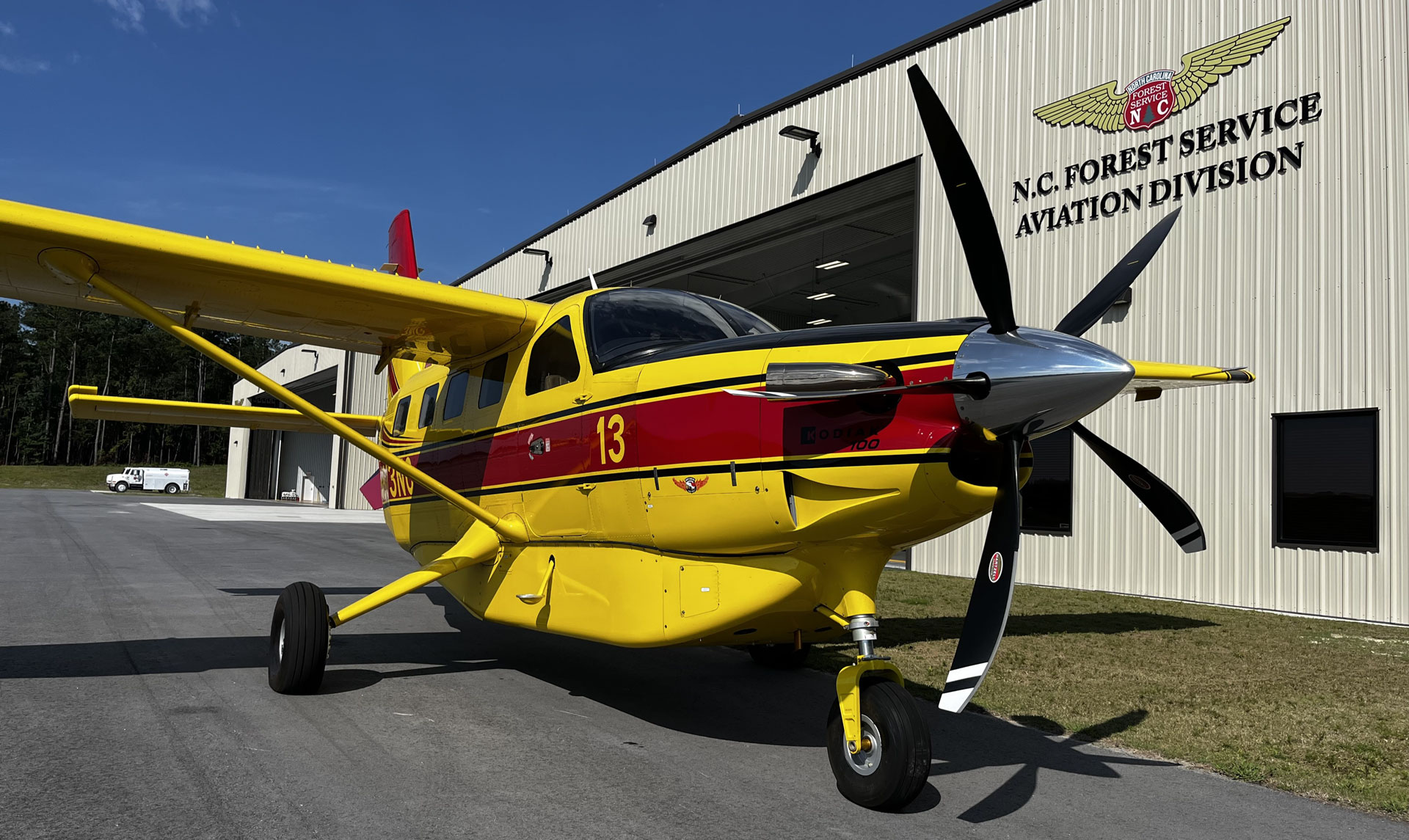APSCON annual convention, Orlando, Florida, July 17, 2023 – Daher has delivered a turboprop-powered Kodiak 100 to the North Carolina Forest Service’s Aviation Division, which becomes a new customer as well as the initial operator of this multi-mission aircraft equipped with a composite five-blade propeller.
The North Carolina Forest Service will utilize its Kodiak 100 as a “load aircraft,” which carries equipment and supplies to operational locations in support of aerial tankers in the wildfire suppression role.

This is Daher’s first new-production Kodiak 100 to be delivered with the composite five-blade propeller configuration from Hartzell Propeller, enhancing the aircraft’s performance and further improving its sustainability.
“As North Carolina’s motto is: ‘First in Flight,’ it’s extremely appropriate that the state’s Forest Service is the initial operator of this latest upgrade for the Kodiak 100,” stated Nicolas Chabbert, the Senior Vice President of Daher’s Aircraft Division.
Tailored specifically for use on the Kodiak 100, the new five-blade propeller incorporates Hartzell’s lightweight Raptor propeller hub technology. The entire unit weighs 13 lbs. less than the Kodiak 100’s current four-blade metal propeller, and reduces the aircraft’s takeoff roll by six percent at maximum gross weight. The propeller is durable by design, with a TBO (time between overhaul) of 4,000 hours/six years, and an industry-leading warranty of six years or up to 4,000 hours. New-production Kodiak 100 Series III aircraft are now available with the five-blade composite propeller as an option. The retrofit for all in-service Kodiak 100s is offered via the Hartzell Top Prop program.
“We welcome the Kodiak 100 to the family of aircraft equipped with our five-blade composite propeller, joining Daher’s Kodiak 900 and the TBM 960,” said Hartzell President JJ Frigge. “Hartzell has been producing composite blades since 1978, which are made with a structural carbon fiber that offers superior strength, damage resistance and reparability.”
Key features of Hartzell’s composite propeller blades include a durable nickel-cobalt leading edge, a nickel erosion screen for FOD (foreign object damage) protection, urethane paint for improved erosion protection and the use of aerospace-grade carbon fiber.
The Kodiak 100’s new propeller is 6.6 dB quieter, turning at 2,000 rpm for maximum torque – which is 200 rpm slower than the current four-blade metal propeller. This slower rotation speed also reduces vibration aboard the aircraft and lowers the Kodiak 100’s flyover noise below the European EASA airworthiness authority’s stringent 78 dB(A) requirement.
At a diameter of 96 inches, the five-blade composite propeller has a ground clearance of 16.4 inches, retaining the Kodiak 100’s ability to operate from unprepared strips and in the amphibious version when equipped with floats.
Daher’s Kodiak 100 is a multi-mission workhorse, operated worldwide in applications that range from wildfire suppression, the monitoring of national resources and the protection of public safety to humanitarian services and ISR (intelligence, surveillance and reconnaissance) duties. Of the total 320-plus Kodiak 100s delivered to date, more than 90 are in service with multi-mission operators, logging an estimated 28,500 flight hours annually for this fleet segment.
“With its enormous useful load, off-airport capabilities, simple and rugged design, the Kodiak 100 is ideal for such a broad range of applications,” said Paul Carelli, the Director of Kodiak Flight Operations and Special Missions. “In addition to the performance improvement with Hartzell’s five-blade composite propeller, the aircraft is extremely quiet. This is significant for missions such as forestry and law enforcement, and also is very important when flying recreationally in backcountry environments.”
NOTE: Daher’s Aircraft Division is exhibiting at the Airborne Public Safety Association’s APSCON annual convention this week in Orlando, Florida (Booth #404), where the multi-mission capabilities of its Kodiak 100 and Kodiak 900 are being highlighted.
Media contact:
Jeffrey Lenorovitz
Daher Vice President – Communications
e-mail: j.lenorovitz@daher.com
U.S. mobile telephone: +1 703 615-3646
Int’l mobile telephone: +33 (0)6 80 85 86 25
About Daher – www.daher.com
As an aircraft manufacturer, industrialist, industrial service provider and logistician, Daher achieved a revenue of 1.3 billion euros in 2022. Backed by its family shareholding, Daher has been focused on innovation since its creation in 1863. With more than 10,500 employees and offices in 13 countries, mainly in Europe and North America, Daher designs and develops value-added solutions for its aeronautical and industrial customers and partners.
Daher is on the following social networks:
About Daher’s aircraft product line – www.kodiak.aero / www.tbm.aero
Daher manufactures two families of single-engine turboprop airplanes: the Kodiak utility aircraft in Sandpoint, Idaho, USA, and the very efficient pressurized TBM in Tarbes, France.
The Kodiak 100 Series III is an unpressurized 8-10-seat airplane equipped with Garmin’s G1000 NXi avionics, capable of operating on uneven and unimproved runways, or on water in the amphibious version. Its unique combination of robust construction and remarkable 3,530 lb. useful load has resulted in many additional applications for the Kodiak, including special missions, medevac, as a skydiving platform and more.
Daher introduced the larger Kodiak 900 version in 2022, featuring a fuselage length extension of 3.9 feet for more passenger room and cargo space, a cruise speed increase to 210 KTAS, and a greater useful load while offering a maximum range of 1,129 nm.
Current TBM models in production are the TBM 910, equipped with Garmin’s G1000 Nxi avionics system, controlled by a keypad; and the TBM 960, featuring Pratt & Whitney Canada’s PT6E-66XT engine and a dual-channel digital Engine and Propeller Electronic Control System (EPECS), an autothrottle, Garmin’s G3000 avionics with touchscreen controller, and the HomeSafe™ emergency autoland system. Both models offer increased automation and superior performance.
As of June 15, 2023, a total of 330 Kodiak and 1,150 TBM aircraft had been delivered to international owners and operators, with the global fleet accumulating some 3 million flight hours.
